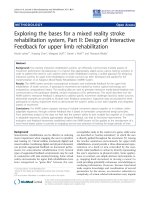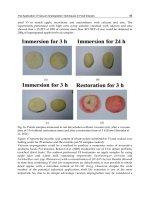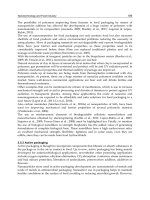Linguistics typology Part II: Further aspects of Typology
Bạn đang xem bản rút gọn của tài liệu. Xem và tải ngay bản đầy đủ của tài liệu tại đây (176.63 KB, 35 trang )
Linguistics: Linguistic
Typology
Part II: Further aspects of
Typology
Recall that
• We are examining some the various ways in
which languages differ
• In the background, the question is how these
differences can be reconciled with the idea
that there is an innate aspect of language
• In our final examples from the last lecture, we
began looking at syntactic typology and word
order
Review, cont.
• We introduced in the abstract some different
types of variation:
– Whether a language has a fixed word-order or not
– What the fixed word-order of the language is in the first
place
– Whether there have to be subject and object Noun Phrases
in the first place
• Our illustration concentrated on the first type,
whether or not a language allows free word
order
Today’s topics
• Word order typology, continued
• Ergativity
• Morphology: Templates…
Comparison
• English:
– The man saw the vessel. (SVO)
• Mapudungun:
– All six possibilities of linear order are
grammatical
• The idea was that in Mapudungun,
information about subject, object etc. is
found in the verbal morphology
Word Orders
• In addition to allowing SVO sentences,
all of the other possible arrangements
are grammatical as well:
– INche metawe pefin.
– Metawe iNche pefin.
– Metawe pefin iNche
– Pefin metawe iNche
– Pefin iNche metawe
SOV
OSV
OVS
VOS
VSO
Agreement and Free Word
Order
•
•
•
•
•
How are the grammatical roles of these noun phrases determined?
Above the verb is given as
pefin
This verb actually has a lot of information in it:
Pe-fi-n
See-Object.Marker-1sS
That is, the verb says that the subject is first person singular, and that
there is a third person object.
Thus the different word orders can be understood as expressing the
same basic proposition
Free Word Order and Case
• Another type of language that has free word order shows case
morphology.
• Consider the following forms of the noun femina ‘woman’ in Latin
(the colon indicates vowel length):
Singular
Plural
Nom. femina feminae
Acc.
feminam femina:s
Dat.
feminae femini:s
Gen.
feminae femina:rum
Abl.
femina: femini:s
• Note that the ends of these words indicate the
grammatical role. On nouns, such morphemes are
called case morphemes
Case, continued
• This means that in Latin, where the word order
is relatively free, the role that a particular NP
plays is encoded on that that NP:
– Femina canem videt.
woman-NOM dog-ACC sees
‘The woman sees the dog’
– Canem femina videt.
– Videt canem femina.
– ….
Nouns and Verbs
• Whatever order the words may appear in, the Nouns
(NPs), as long as the case marking is the same the
basic semantics is the same.
• The information is not entirely marked in the verb, which
conveys person, number, tense, but not the full
message about the event
• The verb here is see, marked for 3s and present tense.
Both dog and woman are 3s…
• Latin probably has a “basic” word order (SOV), but uses
these variants freely to emphasize or deemphasize
different parts of the sentence (Mapudungun too
probably)
Back to basic word orders
• As we discussed above, there are some
languages that do not allow free word order
• Languages (of this type) tend to display a
basic word order, which is used in unmarked
circumstances
• Among these, there are again differences in
terms of what order is employed
Possibilities/Illustrations
• SVO:
– English: The man ate the apple.
• SOV (remember Hindi in the last class):
– Turkish:
• Hasan ưküz-ü ald1.
Hasan ox-ACC bought.
• In these two types, what differs is the relative
position of the verb and the object NP
• Remember that a simple way of thinking of this was that
the tree structures are the same, with the order of V and
the NP object reversed
Remember…
S
NP
Rahul
AuxP
VP
NP
the book
Aux
V
read
“had”
This is the Hindi version. Look carefully at what has
changed.
VOS
• Basic VOS Word Order:
– Malagasy (spoken in Madagascar)
• Nahita ny mpianatra ny vehivavy
saw the student the woman
‘The woman saw the student’
• VOS doesn’t provide the same challenge as
VSO, which we discussed last time (draw the
tree…)
• At the same time, it might be the case that this
isn’t just the “subject mirror image” of SVO
Object-initial?
• While the above patterns are clearly attested,
orders in which the object appears first are hard to
find
• One example of OVS:
– Hixkaryana (Carib, N. Brazil)
• Toto yahosIye kamara.
man grab jaguar
‘The jaguar grabbed the man’
• In many cases the situation is complicated because of what
it means to have a ‘basic’ word order in the first place (e.g.
you can get OVS order in lots of languages; the question is,
is this “basic” or not)
Frequencies
• Some studies take samples of languages and count
the percentages of these types (e.g. Mallinson and
Blake 1981):
–
–
–
–
–
–
SOV: 41%
SVO: 35%
VSO: 9%
VOS: 2%
OVS: 1%
OSV: ??
• While such numbers give us an idea of what’s out there, it is not clear
what else we can learn from them, given that the samples are reflections
of non-linguistic factors (history)
Verb-initial orders: VSO
• VSO:
– Welsh:
• Lladdodd y ddraig y dyn.
killed the dragon the man
‘The dragon killed the man.’
• Question: Can this be derived as
straight-forwardly as SVO/SOV, where
we just change the order of the VP?
Questions
• Specifically: can we “relinearize” the SVO tree
to yield the VSO tree?
• Answer: Not without “crossing lines”
• If we do not want to cross lines, then
something additional must be happening in
VSO languages.
That is…
• Consider:
S
NP
VP
The man
V
NP
killed
the dragon
English questions…
• Remember, English is
– S (AUX) V O
– John didn’t eat the apples
• But in questions, the AUX is moved to a
position that precedes the subject:
– Didn’t John t eat eat apples?
• The same type of solution can be
applied to Welsh (and VSO generally)
Ergativity: An Introduction
• We’ve seen cases like “Nominative” and
“Accusative”; e.g.
– I saw him.
• I = nominative case form of 1st singular
• Him = accusative case form of 3rd singular
• Even in English, where we don’t see it very often (only in pronouns), we
have the following pattern:
– Subject: Nominative case
– Object: Accusative case
• Then we can talk about what is wrong with
– *Me saw he.
– *Us ate.
More Case
• As we saw earlier, some languages like Latin
mark their nouns for different cases more
thoroughly
• Reviewing, note that we can have
– Femina poetam videt.
woman-NOM poet-ACC see-3s
‘The woman sees the soldier’
• Any order of these words means the same
thing
A simple point
• Here’s an additional point about English
and Latin:
– The subject of an intransitive verb is
marked with the same case as the subject
of a transitive verb:
• I ate/I saw him.
• Femina poetam videt/Femina cantat
(as on previous)
woman-NOM sings
Continuing
• Although English has relatively little morphology,
on pronouns, there are distinctions:
– I saw him; *Me saw him.
– *He saw I; He saw me.
– I ran; *Me ran
• Notice that the subject of an intransitive and the
subject of a transitive are identical; objects of
transitives are distinct
• Obvious, right? Not really, because not all
languages work that way.
Illustration
• Dyirbal (spoken in Australia):
– Intransitive
• Numa banaga-nYu
father-ABS return-NONFUT
‘father returned’
– Transitive:
• yabu-Ngu numa bura-n
mother-ERG father-ABS see-NONFUT
‘Mother saw father’
• Compare:
– Numa-Ngu Yabu bura-n `father saw mother’
• Important point: numa ‘father’ is in the same case in the first two examples
• Follow up: The “special” case in the transitive is on yabu ‘mother’



![[TO BE PUBLISHED IN THE GAZETTE OF INDIA, EXTRAORDINARY PART-II, SECTION-3, SUB-SECTION (i)] - MINISTRY OF CORPORATE AFFAIRS potx](https://media.store123doc.com/images/document/14/rc/th/medium_X6qKb5VYeN.jpg)





